
Tom Clancy's Splinter Cell: Blacklist Multiplayer In-Depth Preview
Almost seven years after the release of Splinter Cell: Double Agent, Spies vs. Mercs is finally back. The asymmetrical competitive online mode took a break with the last instalment, Conviction, but now Ubisoft Toronto are bringing it back. Blacklist gives us a new 4v4 mode on top of the original 2v2, along with a much-expanded level of customisation to deliver a revamped version of Spies vs. Mercs.
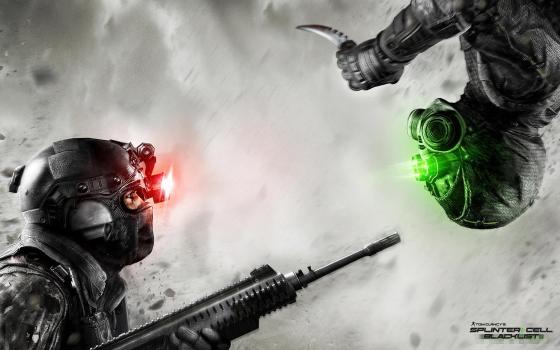
The basic premise remains much the same as in previous games, but I’ll give a little run-down for those that are new:
Spies vs. Mercs splits the players into two distinct classes, both with very different methods of gameplay. One team play as the spies - modelled on Third Echelon operatives, the gameplay for these is similar to that found in Splinter Cell’s singleplayer. Controlled through the third-person, spies have much higher agility than mercs and can traverse the maps more easily, using their ability to move and climb faster, access air vents, and hang from pipes and balconies to their advantage. Their firepower and armour is much lower than that of the mercs, but they have one-hit kill melee moves. Implementing their abilities to hide and use the environment is crucial to success.
The other team are the mercs and play through a first-person perspective. Armed with assault rifles and body armour, they hold a huge advantage in shootouts and standoffs. Flashlights help them sweep through darkened areas and behind possible hiding spots in search of spies, and a motion-tracker helps pinpoint quickly moving targets even in the dark. Grenades can be hurled into vents and other inaccessible areas, but their cumbersome movement requires they climb ladders to reach points that spies can move to in a heartbeat.
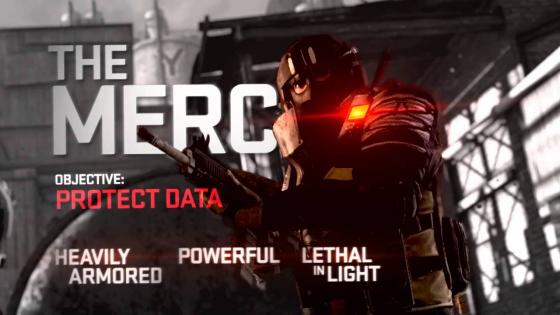
In Splinter Cell: Blacklist, the spies are given three terminals they must try and hack - the sole aim of the mercs is to defend these from the spies and stop the hacks completing once they’ve been initiated. Once a spy starts a hack, they become the ‘hacker’ and have to stay within a certain radius of the terminal. Only one terminal can be hacked at a time, so it’s up to the hacker’s teammates to come help him out - if he dies before the counter reaches 100%, there’s only a short window in which another spy can reactivate the process. When the hacker is killed, expect the mercs to surround the terminal to stop this happening.
Tacked-on multiplayer this certainly isn’t. In past variations, playing as a spy has been much the favourable option, but in Blacklist, the experience of playing a merc is just as much fun. Awareness of the spy’s superior mobility and their need to apply strategy evokes a determination not to be outwitted, and the satisfaction of mowing down a spy in their hiding place, or while attempting to sneak up on you, is huge. The unique context helps pull it away from feeling like a generic FPS and adds more spice to the Splinter Cell recipe.
It’s quite a feat that both classes manage to make the player feel vulnerable, creating a constant tension that follows you around the map: for mercs, it’s the claustrophobic narrowness of the first-person perspective, the paranoia incited by shadows in every corner, and the awareness that a spy could be behind any corner or cover, hanging from any balcony, or lurking in any air vent; for spies, it’s the pressure of finding a position that is cunning without being obvious, and the knowledge that once a merc’s flashlight falls upon you, your chances are sliced down immensely. Neither side feels overpowered - if anything, both feel underpowered. But that’s just the feeling of vulnerability that gives spies vs. mercs its originality.
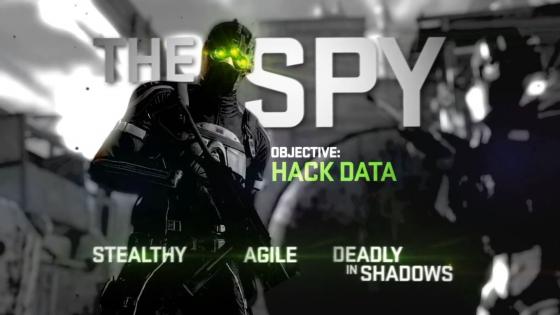
Players on both sides are easily dispatched if they’re not paying attention. As a merc, it’s easy to forget to check a room for hiding spots and to keep an eye behind you, and as a spy it’s just as easy to get lazy with your sneaking and get caught with your pants down. I never once found the mode unbalanced - if I was losing, I could kind of tell that it was my fault. Balance is a difficult thing to achieve in asymmetrical gameplay, but both classes have advantages at long and short range - at long, the mercs have their superior weapons, but the spies can more easily dip out of view and find a suitable escape route/hiding spot. At short, the spies have their one-hit kill melee moves, but the mercs have flashlights/motion-trackers and, again, better guns.
When moving around corners, for instance, it remains completely up in the air as to which class will survive the encounter. Sometimes the spy will get their melee kill in, and sometimes they’ll be gunned down before they have a chance. It depends not on which class you are, but on which player is paying the most attention. It can be decided by various gadgets such as sonar goggles and heartbeat sensors, but on a blind encounter, either player could win.
Speaking of gadgets, there’s vastly more available to you in this revamped version of spies vs. mercs. Though there are several set classes for each side, the real fun comes from custom classes. The options have been increased, allowing you to change everything from your guns and gadgets, down to your boots and gloves.
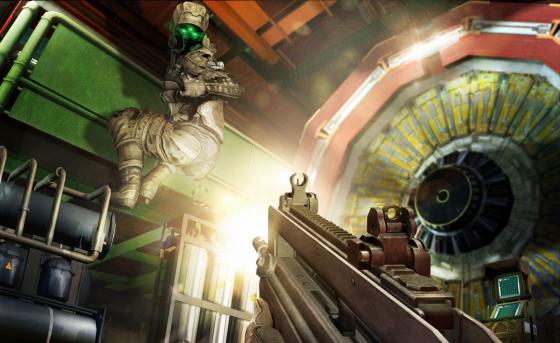
Various suits are available for both teams, and each offers a usable power. Spies have: the Digital Ghillie suit, which allows them to go invisible for a short period; the Overcharge suit, which acts something like an EMP, destroying enemy devices within a certain range; and the Intel suit, which locates close-by enemies by tracking their heartbeat. Mercs have: the Disruptor suit, which disables enemy gadgets and goggles; the Adrenaline suit for added health, speed and regeneration; and the UAV suit, which allows use of a controllable, detonating drone that can be flown around until its battery runs out.
Spy gadgets include smoke grenades, EMPs, flashbangs, the mighty sticky-cam and a Trophy System, which is a stationary device that destroys nearby enemy grenades and drones. The mercs have proximity mines, gas grenades, frag grenades, deployable intel devices and weapon/gadget resupply packs. One gadget can be equipped to a class.
The goggles available to spies are nightvision, thermal and sonar, all of which have featured in past Splinter Cell games. The mercs can use a motion tracker, which appears as a bar at the bottom of the screen, blipping like something from Aliens when there’s a quickly moving spy in the vicinity (if only Colonial Marines had half the level of suspense as this...). There’s also the RFD goggles, which detect electronic devices, and the ATS, which picks up enemy sounds from weapons and movement.
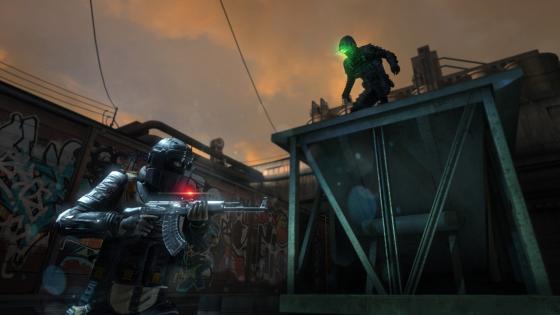
As well as these, you can change your headgear, trousers, gloves and boots to receive bonuses for all manner of things such as reload speed, better armour, quicker running/climbing, or even gain abilities like an immunity to UAVs, or preventing the enemy’s crosshair turning red when aimed at you.
In terms of arsenal, handguns are the spy’s primary weapon, of which there are four to choose from. There are plenty of automatic submachine gun-type weapons to choose from as a secondary, with one non-lethal option in the form of stun-crossbow. The mercs have a rather more noticeable armoury which mainly consists of heavy-duty assault rifles such as the AK-47. Also an option are shotguns, which are a one-shot kill at close range. And solve the issue of moving around corners, incidentally.
Spies vs. mercs is a unique competitive multiplayer, working within the Splinter Cell framework. It takes a little getting used to as you learn the basics of things like checking terminals for proximity mines, scoping whether the pipe you’re hanging from will get you spotted, learning the regular hiding spots, and judging the abilities of you and your enemy. But rest assured that once you’ve found the ropes, spies vs. mercs will be an addictive mode which will ensure Splinter Cell: Blacklist remains in your disc-tray long after the singleplayer has been completed.











COMMENTS
Kaostic - 01:40pm, 4th December 2018
I love the Splinter Cell games but never actually played this game mode. Thinking about picking this up :) You know... when I have money...
Bamalamb - 01:40pm, 4th December 2018
Love me some splinter cell, double agent multiplayer was great and i can only look forward to the long awaited revival of the multiplayer.